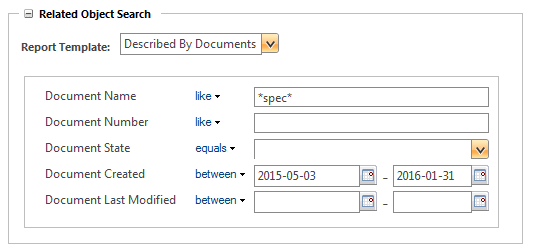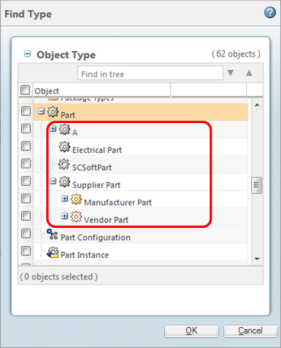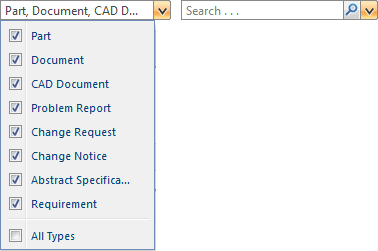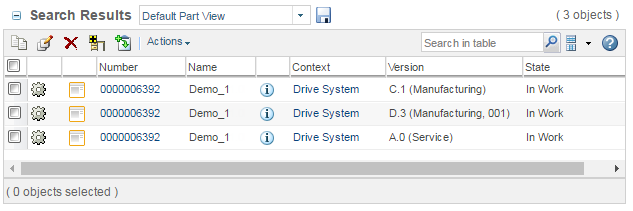Windchill Search Preferences
Preference settings determine some of the search behavior. For more information, see
Preference Management.
The visibility of preferences is determined by how you access the Preference Management utility:
• Some preferences can be set at the user level.
To view and modify your individual user preferences, select
Quick Links > > . Expand the
Search preferences group.
• Some preferences must be set at context, organization, or site level by an administrator.
From the
Navigator, select
Utilities under a specific context, organization, or site. Click
Preference Management under the
Business Administration utility category. Expand the
Search preferences group.
If a preference is visible but cannot be edited, then this preference has been locked at a higher level.
|
|
In the tables below, “Visibility” indicates the lowest level at which the preference can be set. For example, “Site” means that only site administrators can view or set the preference. “User” means that an individual user, context administrator, organization administrator, and site administrator can view or set the preference.
Your local administrators might change the default preference visibility.
|
To change a preference, select
Set Preference from the right-click actions menu. For more information, see
Setting a Preference.
Advanced Search Default Types List
|
Visibility
|
Site
|
|
Description
|
This preference determines the list of searchable types that appear under My Favorite Types on the Advanced Search page. Once a user begins using the advanced search, the user-selected options are retained, rather than the ones set by this preference.
|
|
Resetting this preference also resets any customizations users have made to their My Favorite Types list.
This preference does not restrict the types that users can search when performing an advanced search.
|
|
All Applicable Object Types Search
|
Visibility
|
User
|
|
Description
|
This preference determines the following:
• The object types that are included when you select All Types for a global search or an advanced search.
• The list of types available from the Find Type window when you select > on the Advanced Search page. Click the find icon  next to the Value field to add or remove object types. | The initial default is set in the SearchableTypes.properties file. If you are an administrator, you should access the Advanced Search page at least once before changing the search preference. |
|
Enable Index Search
|
Default
|
Yes
|
|
Visibility
|
User
|
|
Description
|
Use the Windchill search index when performing a global search or entering a value in the Keyword field on the Advanced Search page. For more information, see Keyword Search Rules.
|
|
This preference is only applicable when Windchill Index Search is installed. Select > > > to verify whether Windchill Index Search is installed.
|
|
Enable Related Object Search
|
Default
|
No
|
|
Visibility
|
Site
|
|
Description
|
Set this preference to Yes to display the Related Object Search field on the Advanced Search page: This field is available when you perform a search for a single object type. The object type must have an associated report template. For more information, see Related Object Search. |
Enable Search Facets
|
Default
|
No
|
|
Visibility
|
User
|
|
Description
|
Set this preference to Yes to display facets with the Search Results table.
When using faceted search results, a Refine Results side panel appears next to your search results. Use this panel to narrow your search results by selecting or deselecting attributes: | This preference is only applicable if Windchill Index Search is installed and enabled. However, if you have Windchill PartsLink installed, facets can appear when performing a classification search regardless of whether Windchill Index Search is also installed. |
|
Excluded Part Subtypes
|
Visibility
|
User
|
|
Description
|
For searches that include the part object type, you can select part subtypes to exclude from the search results.
Part subtypes are often created and customized according to the needs of your site. You can view subtypes from the Find Type window: |
Global Search Default Types List
|
Visibility
|
User
|
|
Description
|
This preference specifies the object types displayed in the global search drop-down menu: |
Implicit Wildcards for Search in Structures
|
Default
|
Yes
|
|
Visibility
|
User
|
|
Description
|
Determines whether wildcards are implicit in structure-related search windows, such as Insert Existing.
• When set to Yes, wildcards are assumed at the beginning and ending of search criteria.
• When set to No, wildcards are not assumed, but you can manually enter wildcards to return a broader range of search results.
|
Keyword Search Behavior
|
Default
|
Keyword
|
|
Visibility
|
User
|
|
Description
|
This preference determines how keyword searches are interpreted:
• Name—Keyword is searched against the Name attribute only.
• Number—Keyword is searched against the Number attribute only.
• Name & Number—Keyword is searched against the Name and Number attributes only.
• Keyword—Keyword is searched against all indexed metadata and primary file content.
|
|
When using indexed searches, this preference only applies when the Search Mode preference is set to Simple.
|
|
|
This preference does not apply when performing keyword searches from the Classification Explorer.
|
|
Latest Version Search
|
Default
|
No
|
|
Visibility
|
User
|
|
Description
|
Use this preference to limit the search results so that only the latest version appears. Otherwise, the latest iteration of each revision appears (assuming each version matches the search criteria.) This preference only applies to objects that have been revised.
For example, you perform a search that includes an object named “Part-1.” Part-1 has been revised several times, and the following versions fulfill your search criteria:
|
Part-1
|
A.5
|
Match
|
|
Part-1
|
B.2
|
No Match
|
|
Part-1
|
C.8
|
Match
|
|
Part-1
|
D.6
|
No Match
|
• If this preference is set to No, the Search Results table displays the following objects:
Part-1 A.5
Part-1 C.8
• If this preference is set to Yes, the Search Results table displays the following object:
Part-1 C.8
|
|
When set to Yes, the latest version of each view version is returned. If an alternate BOM exists, the latest version of the alternate BOM is returned as well. For example: |
|
Recently visited Context Picker list size
|
Default
|
5
|
|
Visibility
|
User
|
|
Description
|
If you are a member of more than one context and you create a new document using desktop integration, then the New Document window includes a Set Context step. To complete this step, you can perform a context search or you can select from a drop-down menu that displays your recently visited contexts. This preference controls how many contexts appear in the Context drop-down menu.
|
Search Mode
|
Default
|
Simple
|
|
Visibility
|
User
|
|
Description
|
This preference determines how keyword searches are interpreted by the Solr search engine:
• Simple—Search using the standard AND and OR operators. Allow the Windchill Index Search to process keywords.
• Advanced—Allows you to use Solr query language syntax for keyword searches. For more information, see Advanced Mode Searching.
|
|
This preference is only applicable if you have Windchill Index Search installed and enabled.
|
|
Thumbnail Display in Search Results
|
Default
|
No
|
|
Visibility
|
Site
|
|
Description
|
When available, display thumbnail images in search results. Thumbnails are only available for objects that are viewable in Creo View and which have a generated thumbnail image.
|
|
Enabling thumbnails slows search results from loading.
|
|




